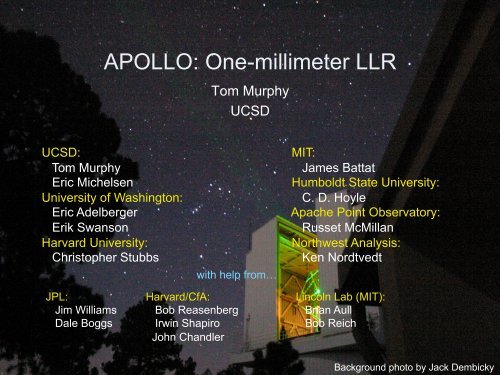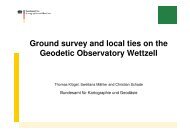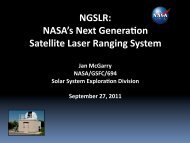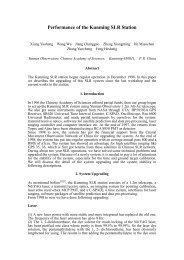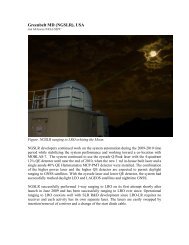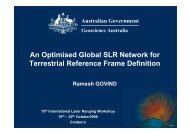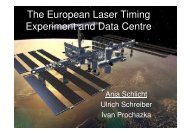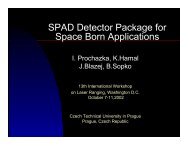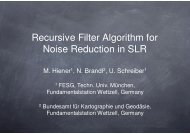You also want an ePaper? Increase the reach of your titles
YUMPU automatically turns print PDFs into web optimized ePapers that Google loves.
<strong>APOLLO</strong>: <strong>One</strong>-<strong>millimeter</strong> <strong>LLR</strong><br />
Tom Murphy<br />
UCSD<br />
UCSD: MIT:<br />
Tom Murphy James Battat<br />
Eric Michelsen Humboldt State University:<br />
University of Washington: C. D. Hoyle<br />
Eric Adelberger Apache Point Observatory:<br />
Erik Swanson Russet McMillan<br />
Harvard University: Northwest Analysis:<br />
Christopher Stubbs Ken Nordtvedt<br />
with help from…<br />
JPL: Harvard/CfA: Lincoln Lab (MIT):<br />
Jim Williams Bob Reasenberg Brian Aull<br />
Dale Boggs Irwin Shapiro Bob Reich<br />
John Chandler<br />
Background photo by Jack Dembicky
Testing Gravity<br />
• Gravity is the most poorly-tested of the fundamental forces<br />
– owing to its relative weakness<br />
– how do we reconcile the incompatibility of gravity and quantum<br />
mechanics?<br />
– is the apparent acceleration of the universe a consequence of our not<br />
understanding large-scale gravity?<br />
• Lunar Laser Ranging (<strong>LLR</strong>) provides many of our most incisive<br />
tests of gravity<br />
– tests Weak Equivalence Principle to Δa/a < 10 -13<br />
– tests the Strong Equivalence Principle to < 4×10 -4<br />
– time-rate-of-change of G: < 10 -12 per year<br />
– geodetic precession: to < 0.6%<br />
– 1/r 2 force law: to < 10 -10 times the strength of gravity (at 10 8 m scales)<br />
– gravitomagnetism (frame-dragging) to < 0.1%<br />
• <strong>APOLLO</strong>, through 1 mm ranging, will improve all of these limits by<br />
approximately 10×<br />
2008.10.14 IWLR 16, Poznan 2
Historic <strong>LLR</strong> Range Precision<br />
2008.10.14 IWLR 16, Poznan 3
<strong>APOLLO</strong>: Achieving the 1 mm Goal<br />
• <strong>APOLLO</strong> offers order-of-magnitude<br />
improvements to <strong>LLR</strong> by:<br />
– Using a 3.5 m telescope at a high<br />
elevation site<br />
– Using a 16-element APD array<br />
– Operating at 20 Hz pulse rate<br />
– Multiplexed timing capable of detecting<br />
multiple photons per shot<br />
– Tight integration of experiment with<br />
analysis<br />
– Having a fund-grabbing acronym<br />
• <strong>APOLLO</strong> is jointly funded by the NSF and<br />
by <strong>NASA</strong><br />
2008.10.14 IWLR 16, Poznan 4
<strong>APOLLO</strong> Instrument Overview<br />
• Laser:<br />
– 532 nm Nd:YAG, mode-locked,<br />
cavity-dumped<br />
– 90 ps pulse width<br />
– 115 mJ per pulse<br />
– 20 Hz<br />
– 2.3 W average power<br />
• Detector: APD Array<br />
– 4×4 Silicon array made by Lincoln Lab<br />
– 30 µm elements on 100 µm centers<br />
– Lenslet array in front recovers fillfactor<br />
– 1.4 arcsec on a side (0.35 arcsec per<br />
element)<br />
– allows multi-photon returns<br />
– permits real-time tracking<br />
2008.10.14 IWLR 16, Poznan 5
Laser on Telescope<br />
2008.10.14 IWLR 16, Poznan 6
For a complete description of instrument,<br />
see the article published in the Publications<br />
of the Astronomical Society of the Pacific<br />
(PASP), volume 120, p. 20 (2008)<br />
System in Action<br />
2008.10.14 IWLR 16, Poznan 7
Apollo 15<br />
<strong>APOLLO</strong> Example Data<br />
2007.11.19<br />
Apollo 11<br />
red curves are theoretical which profiles: array get is physically convolved smaller? with fiducial to make lunar return<br />
represents system<br />
capability: laser;<br />
detector; timing<br />
electronics; etc.<br />
RMS = 120 ps<br />
(18 mm)<br />
• 6624 photons in 5000 shots<br />
• 369,840,578,287.4 ± 0.8 mm<br />
• 4 detections with 10 photons<br />
• 2344 photons in 5000 shots<br />
• 369,817,674,951.1 ± 0.7 mm<br />
• 1 detection with 8 photons<br />
2008.10.14 IWLR 16, Poznan 8
Sensing Array Size and Orientation<br />
2007.10.28 2007.10.29 2007.11.19 2007.11.20<br />
2008.10.14 IWLR 16, Poznan 9
Reflector<br />
<strong>APOLLO</strong> Return Rates<br />
<strong>APOLLO</strong> max<br />
photons/run<br />
<strong>APOLLO</strong> max<br />
photons/5-min<br />
• <strong>APOLLO</strong>’s best runs are solidly in the multiple photon/shot regime<br />
– APD array is crucial for catching all the photons<br />
<strong>APOLLO</strong> max<br />
photons/shot<br />
(5 min avg)<br />
– Have seen 11 of 13 functioning APD elements register lunar photons in<br />
a single shot<br />
– see approximate 1:1:3 Apollo reflector ratio; Lunokhod is reduced<br />
• Can operate at full moon (background not limiting), but signal is far<br />
weaker than expected (by 100×)<br />
• Overall signal is still about 10× weaker than we expect<br />
<strong>APOLLO</strong> max<br />
photons/shot<br />
(15 sec avg)<br />
Apollo 11 4288 (25×) 3120 (38×) 0.52 1.0<br />
Apollo 14 5100 (24×) 5825 (44×) 0.97 1.4<br />
Apollo 15 12524 (21×) 9915 (35×) 1.65 2.8<br />
Lunokhod 2 750 (11×) 900 (31×) 0.15 0.24<br />
(relative to pre-<strong>APOLLO</strong> record)<br />
2008.10.14 IWLR 16, Poznan 10
Strong Apollo 15 Run: Stripchart<br />
11-photon return<br />
many 10-photon returns<br />
Stripchart based on<br />
300-shot (15 sec)<br />
running average<br />
rate (blue curve),<br />
represented in<br />
photons per shot<br />
(left axis).<br />
Red points indicate<br />
photon count (within<br />
1 ns of lunar center)<br />
for each shot (right<br />
axis).<br />
<strong>One</strong> shot delivered<br />
11 photons, many<br />
delivered 10, and<br />
so on.<br />
2008.10.14 IWLR 16, Poznan 11
Catching All the Photons?<br />
mean = 1.26<br />
81% mult. phot.<br />
mean = 1.08<br />
64% mult. phot.<br />
The Lunar returns (blue; left) deviate substantially from binomial (red) (due to speckle)<br />
The Fiducials are faithful to binomial (thus the lunar deviation is not a systematic issue)<br />
But the trailing-off of lunars suggests we’re catching (virtually) all the photons<br />
2008.10.14 IWLR 16, Poznan 12
The Full Moon Hole<br />
The 2.7 m McDonald <strong>LLR</strong> station routinely got<br />
full-moon normal points, until about 1980. They<br />
ultimately stopped scheduling full moon times.<br />
This log plot shows our Apollo<br />
15 return rates as a function of<br />
lunar phase angle, D. Within 15°<br />
of full moon (D=180°), we see a<br />
hundred-fold reduction in signal.<br />
This is not due to background.<br />
fraction of NPs within<br />
15° of full moon<br />
proportional<br />
expectation<br />
2008.10.14 IWLR 16, Poznan 13
shaded → recent results<br />
Reaching the Millimeter Goal?<br />
median = 1.8 mm<br />
1.1 mm recent<br />
• 1 <strong>millimeter</strong> quality data is<br />
frequently achieved<br />
– especially since Sept. 2007<br />
– represents combined<br />
performance per reflector per<br />
night (< 1 hour observing<br />
session)<br />
– random uncertainty only<br />
• Virtually all nights deliver<br />
better than 4 mm, and 2 mm<br />
is typical<br />
2008.10.14 IWLR 16, Poznan 14
15 mm<br />
Residuals Within a Run<br />
individual error bars: σ ≈ ±1.5 mm<br />
• Breaking a 10,000shot<br />
run into 5 chunks,<br />
we can evaluate the<br />
stability of our<br />
measurement<br />
• Comparison is against<br />
imperfect prediction,<br />
which can leave linear<br />
drift<br />
• No scatter beyond that<br />
expected statistically<br />
– consistent behavior<br />
for each run we’ve<br />
evaluated in this<br />
manner<br />
2008.10.14 IWLR 16, Poznan 15
Apollo 15 reflector<br />
2008.02.18<br />
Residuals Run-to-Run<br />
0.66 mm<br />
8457 photons; 10k shots<br />
1.45 mm<br />
1483 photons; 3k shots<br />
1.16 mm<br />
2269 photons; 3k shots<br />
1.73 mm<br />
901 photons; 2k shots<br />
We can get 1 mm<br />
range precision in<br />
single “runs” (
JPL Model Residuals<br />
residuals plot redacted at request of JPL<br />
Data points→individual “runs”; alternating shades→whole sessions<br />
<strong>APOLLO</strong> data points<br />
processed together<br />
with 16,000 ranges<br />
over 38 years shows<br />
consistency with<br />
model orbit<br />
Fit is not yet perfect,<br />
but this is expected<br />
when the model sees<br />
high-quality data for<br />
the first time, and<br />
<strong>APOLLO</strong> data<br />
reduction is still<br />
evolving as well<br />
Weighted RMS is<br />
about 8 mm<br />
χ ≈ 3 for this fit<br />
2008.10.14 IWLR 16, Poznan 17
<strong>APOLLO</strong> Impact on Model<br />
residuals plot redacted at request of JPL<br />
Data points→individual “runs”; alternating shades→whole sessions<br />
If <strong>APOLLO</strong> data is<br />
down-weighted to<br />
15 mm, we see what<br />
the model would do<br />
without <strong>APOLLO</strong>-<br />
quality data<br />
Answer: large (40 mm)<br />
adjustments to lunar<br />
orientation—as seen<br />
via reflector offsets<br />
(e.g., arrowed<br />
sessions)<br />
May lead to improved<br />
understanding of lunar<br />
interior, but also<br />
sharpens the picture<br />
for elucidating grav.<br />
physics phenomena<br />
2008.10.14 IWLR 16, Poznan 18
Current Status and Future Plans<br />
• <strong>APOLLO</strong> is now beginning its third year of steady science<br />
campaign<br />
– our very best month was 2008 September, so still improving<br />
– we expect science results will be possible soon, awaiting model<br />
developments<br />
– working on data reduction subtleties (first photon bias, 16-element<br />
detector array)<br />
• Part of the <strong>APOLLO</strong> goal is to more tightly integrate<br />
experimental and analysis efforts<br />
– this has been surprisingly difficult<br />
– asymmetric expectations (data vs. analysis results)<br />
– starting to work with Reasenberg/Shapiro/Chandler at Harvard/CfA<br />
to update the Planetary Ephemeris Program (PEP) to become an<br />
OPEN SOURCE cutting-edge analysis tool for <strong>LLR</strong> and solar<br />
system analyses<br />
– contact me if interested in contributing<br />
2008.10.14 IWLR 16, Poznan 19


